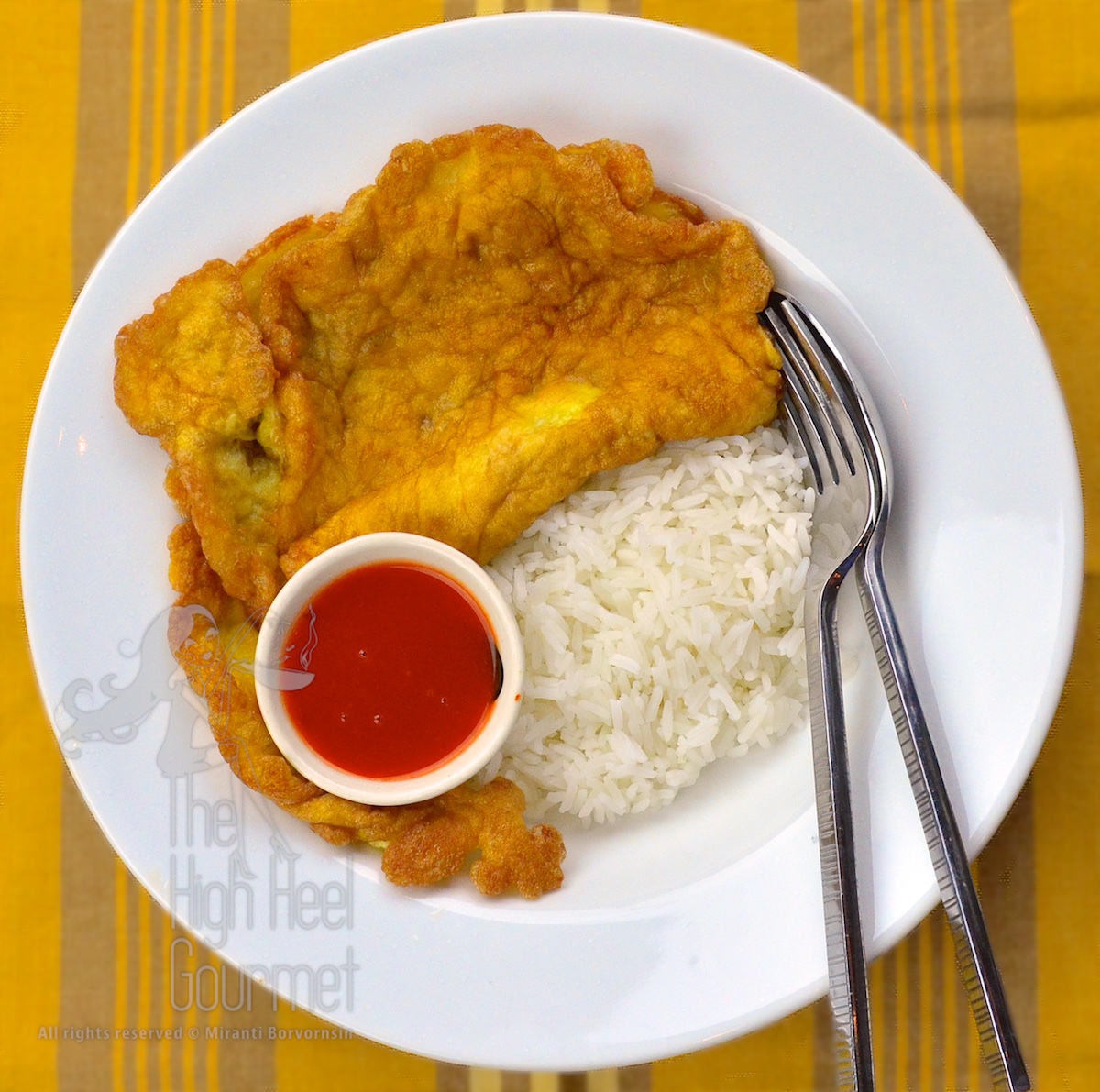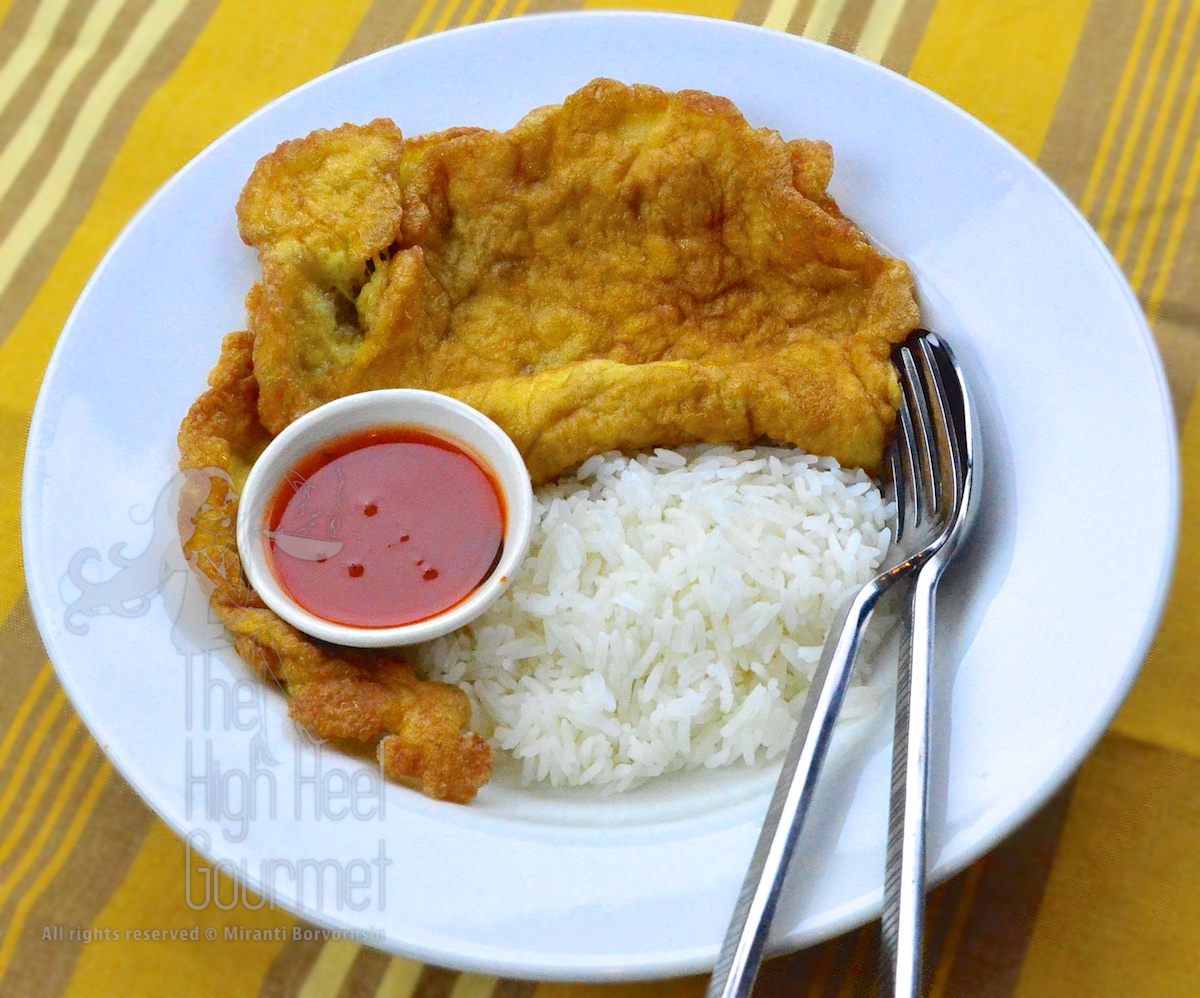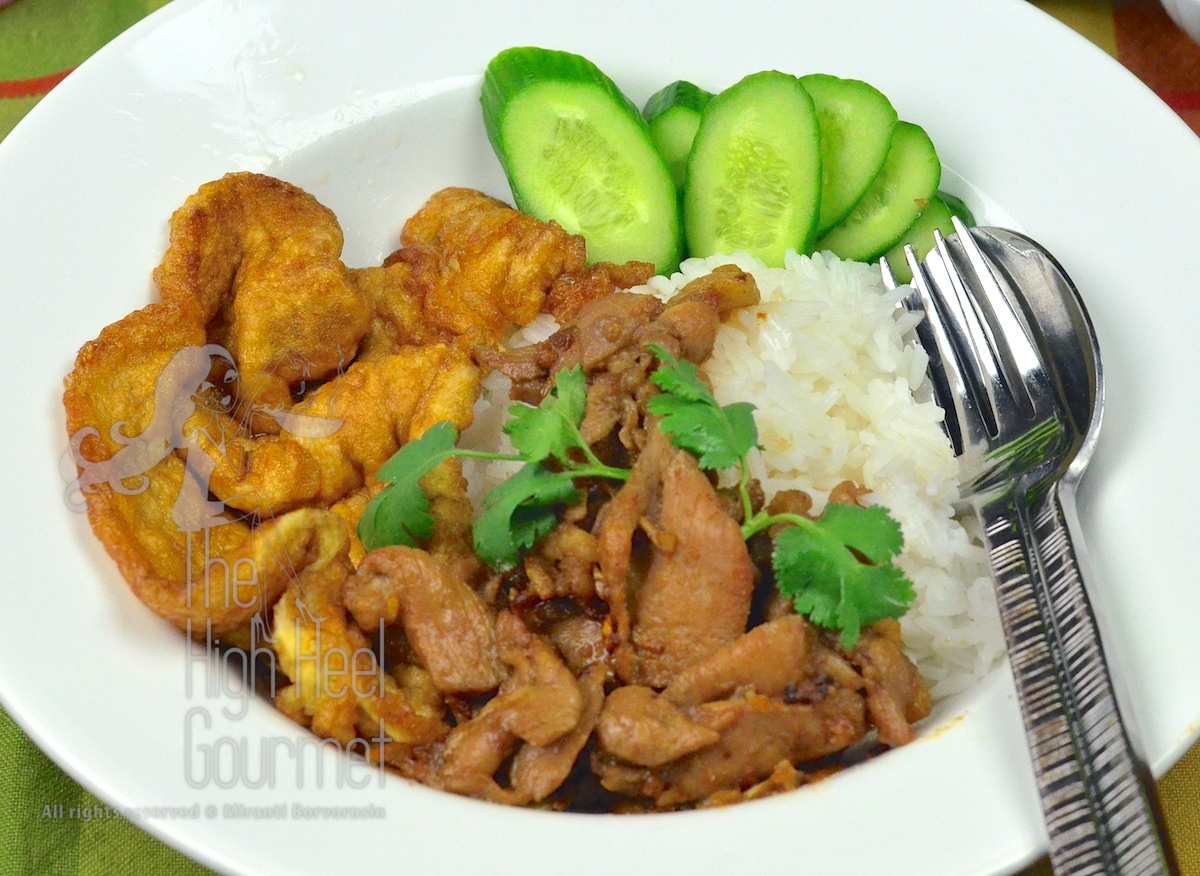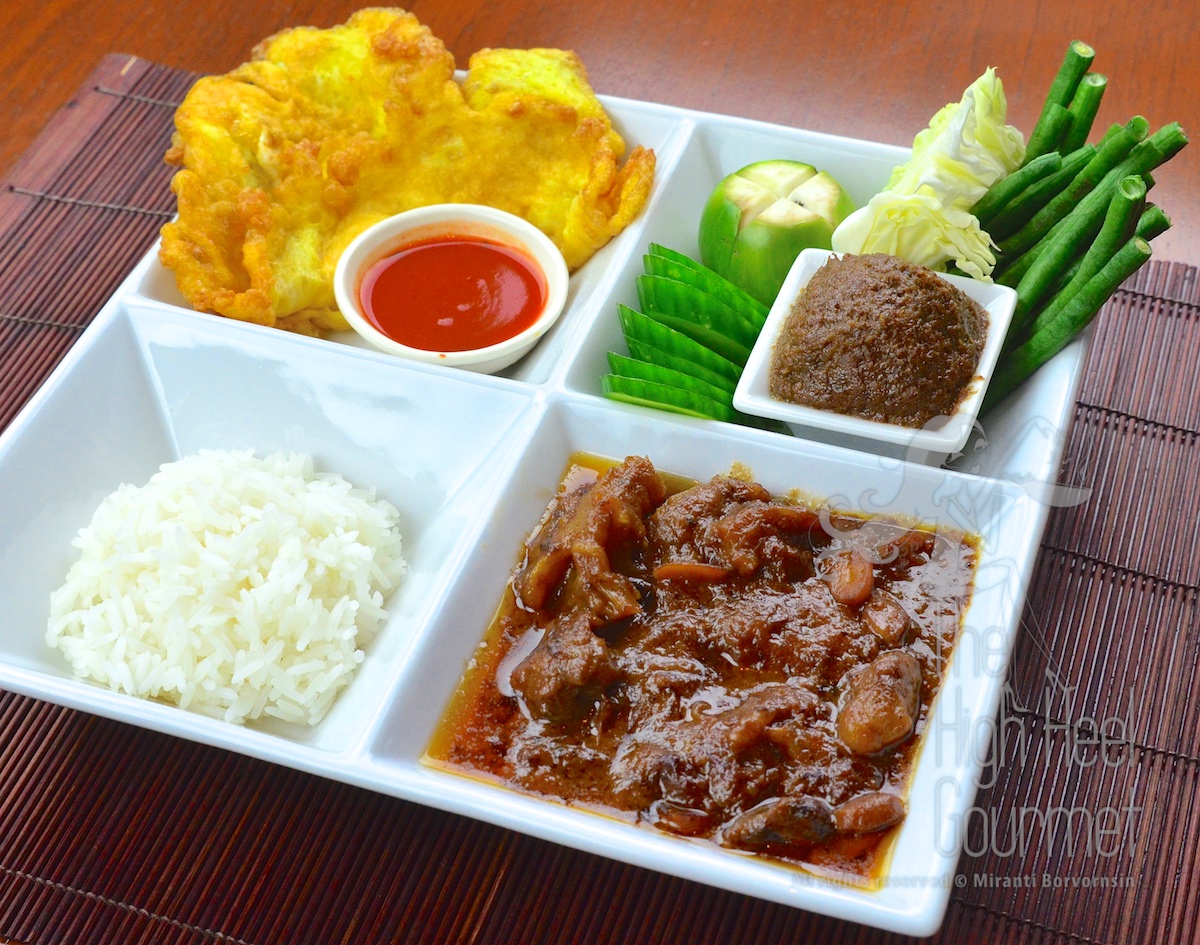I know some of you are probably screaming “bingo” when you see the title here. This is my long lost series. I blogged about the first Khai Jiao over two years ago back when I didn’t even have the light to shoot the finished dish like a pro 😉
Well, I’m still a little embarrassed to be blogging about this, all the same, but the Khai Jiao fans have been increasing the pressure. They threaten to move in and make me cook Khai Jiao for them if I don’t blog about this. Well, to protect my territory, I think it’s time to throw them the second bone.
For those of you who are confused what Khai Jiao is, it’s the Thai style omelette on paper. It’s actually the Thai comfort food, kind of like the American PB&J. Some people also compare Khai Jiao to mac and cheese. I think they honor this omelette a little too far. It’s not as complicated as mac and cheese, for sure.
As I described earlier on the first episode of the series, there are so many different ways of cooking this to get several different results. I recommend you to go back and read the first episode, the crispy omelette, too.
When I blogged about Moo Todd Kratiem Phrik Thai, the fried pork with garlic and pepper, I also mentioned that you can eat it with Khai Jiao, and included the picture of one Khai Jiao too. That’s the one we are going to learn how to make this time, the “Standard” kind.
Well for those of you who went all the way and read the first episode, don’t scream just yet. I didn’t list this one in the first episode because to me this is the easiest, the nothing Khai Jiao, you know. It’s not fancy. Everyone in Thailand knows how to make it…it’s too standard so I FORGOT…sorry about that! It’s like the most basic of the PB&J, plain white bread from the grocery, Jiff peanut butter and concord grape jelly—no fuss—that is comparable to this standard omelette.
This is probably the very first dish that most Thai people learn how to make. You don’t need to go to any cooking school to learn, but learn from watching and eating it many times thoughout your life, just like how American learn how to make sandwiches. You watch the adult making it for you then you just mimic it.
Also, it’s such a heartwarming dish when you are away from home, too. When I first went out of the country, living with a host family, eating western foods for about a week (or two if the mum of that family was a good cook). Then I would want my rice topped with Khai Jiao.
The character of the standard Khai Jiao is flat, wide, round or not round (depends on the cook), slightly brown in some spots, crispy but not too crispy on the edge, not so fluffy on the inside but not crispy either, yellow (of course…are you crazy? I’ve never seen the egg that was laid with a blue yolk!). Geezzzz… It’s difficult to describe a plain Jane item, you know.
Well it’s no doubt that this plain Jane is the queen of the comfort food for the Thai people. You can test this theory yourself. If you ask a Thai which dishes are their top five comfort foods, the Khai Jiao would make the list. It it doesn’t, you can just simply remind them like “How about the Thai omelette?” They would bite the bait for sure.
This standard omelette is normally served at every “cook to order” food stall in Thailand. It’s served as a side dish for what ever you order, either stir fried with holy basil – Pad Kra-Prao, stir fried with chili – Pad Phrik, fried with garlic and pepper – Todd Krater Phrik Thai. It also goes good with the sour curries –Kaeng Som or any curries.
This is again the standard version without any filling, but it’s not limited to no filling at all. You can add anything you want, but don’t add too much, no more than a tablespoon per each egg. The popular things to add are these:
Green Onion
Shallots
Chai Po, or pickled turnip (The same one we used in Pad Thai or the sweet kind)
Pickled garlic
The theory of cooking the standard omelette is not that different than the crispy omelette but with the crispy omelette we need to beat the eggs with the motion that can add a lot of air into the egg. The standard omelette is not going to need that much air, but you need to beat the egg anyway so the egg white, yolk and the condiments blend well.
You can think of the standard omelette as the mutt, a mix between crispy omelette and the fluffy omelette (that you don’t know how to make yet) but the fact is the standard omelette is the original omelette that is the basis for the other different kinds.
I see a lot of Thai omelette recipes on the internet. I don’t know where these cooks come from but they put “corn starch” in it, too. Some of them are proud of this so called “secret”. Well, I don’t have secret like that and never will. All my life that I lived in Thailand, I never added starch of any kind to the Khai Jiao just to make it crispy. The egg can crisp on its own.
This is my list of techniques for the standard omelette.
1) The ingredient that would make the standard omelette different than the crispy omelette is the liquid that is added to the egg mixture. The liquid that contains water would make the egg fluff, because once the water touches the heat from the oil it will turn into steam and of course try to escape and that would make the egg tender inside.
2) You can use either a flat bottom pan or a wok to make the standard omelette. Unlike the crispy omelette that I would definitely recommend using the wok for, the heat required to make the standard omelette isn’t that high.
3) The amount of oil will not be as much as the crispy omelette, but still a frightening lot. You have to remember that the egg won’t absorb ALL the oil I suggest usiing here, but without enough oil you won’t get the edge of the omelette crispy.
1 egg 2-3 tablespoons
2 eggs 3-4 tablespoons
3 eggs 4-5 tablespoons
4 eggs 5-6 tablespoons
To tell you the truth, I never measure the amount of oil. I just estimate it. The oil has to cover the bottom of the pan and should be at least quarter inch above the bottom of the pan. The more oil you add, the more crispy edge you will get, but don’t go overboard. It will take too long to heat it.
4) The “beating” technique. You need to beat the eggs with a fork. Don’t try to make standard Khai Jiao using a whisk. You will end up getting the crispy omelette or maybe even a deep-fried soufflé.
This time you can beat the egg however you like, really. The standard omelette is the most forgiving type. You just have to beat it. The result depends upon how you beat the egg.
If you beat vigorously by lifting the fork above the surface of the egg mixture, you add more air to the egg white and you will get the result that has more crispy parts on the edges.
If you beat the eggs by moving the fork in a circle UNDERNEATH the surface of the eggs and don’t let the fork hit the air, you will get an omelette that is more fluffy in the middle and less crispy on the edge.
You can almost predict the result by the amount of foam that shows up on the surface of the finished beaten egg mixture. The more foam, the more crispy edge, less foam is the more fluffy middle.
5) The pouring technique: the height where you pour the egg is determines the end result as well. The higher you pour, the more crispy edge you would get. The lower pour gives a more fluffy middle.
6) The temperature used to control the result: I leave this technique to last because I’m ashamed of myself. I never measure the temperature, sorry. 🙁 I only look for smoke. The more smoke you let the oil get, the more crispy edge.
You never pour in the egg mixture until you see the smoke, or your egg will absorb too much oil and it gets really greasy.
Alright, we have to test our theory. Get the lab ready.
Ingredients:
Eggs, as few or as many as you like
Oil look above for the amount of oil you need to cook the amount of egg
Fish sauce 1 teaspoon per each egg (Please, don’t substitute it with soy sauce)
Lime juice 1/2 a teaspoon per each egg. You can also use vinegar, lemon juice, water or milk. Try all of those to see the different result.
Method:
Due to the high heat and the hot oil I used to fried the omelette. I think it’s easier to show you the method in the video instead of pictures.
[wpvideo E2iOdPEd]
1) Put the oil in the pan or wok; heat at high heat.
2) Crack the eggs, add fish sauce and lime juice, and start beating while you wait for the oil to get hot. Look up the technique #4 to determine your desired result.
3) Once the oil starts to give smoke, lower the heat down to medium high and pour the egg mixture into the oil. Look up the technique #5 to determine how high you want to pour. I pour mine at 6” above the surface of the oil.
4)Try to let the entire egg mixture touch the oil as much as possible, but if there is some left on the surface don’t worry. Wait until the eggs set at the bottom before you flip the omelette or you will break it.
5) This is the most difficult step for the beginner. You don’t know when to flip. Or you don’t have the skill to flip without breaking. It’s partial practice and the other is science.
If you let the omelette sit in the oil without disturbing for a bit, not very long, about 45 seconds – 1 minute, you would be able to flip it without breaking it. It takes longer if you use more eggs. How can you tell, then? You can use the spatula to lift the side of the omelette to see the color. If the color is still very pale, leave it alone. The color needs to be nearly golden before you can turn it.
Flip and let the liquid egg mixture flow off and touch the hot oil before you drop the omelette on top and wait again.
6) The omelette doesn’t take that long at all to cook. I usually want to flip it back two more times just before I lift it off the oil to eliminate the excess oil and make the outside more crispy.
7) I drop it on a paper towel to absorb the excess oil after I shake it out before I take it away from the pan. I put another paper towel on top of it too.
Then serve with white rice and Thai Sriracha sauce. (I hope you know that I really meant for the REAL THAI Sriracha sauce and not the brand with one rooster on the plastic bottle and the green tips. That one should have been called “California sauce” not Sriracha!)




Hi Miranti, great tutorial! I have never eaten a Thai omelette before, so I’m curious to try it.
Nice post! Love this with sour curry.
That’s the ultimate pair. Every Thai person love that so much.
Reblogged this on The Militant Negro™.
Looks and sounds delicious! I have never tried this. Thanks for the tip.
What a great and also funny post! The fried omelette looks so delicious, I wish I could try it!
I recently learned about Thai omelet and I love it. I’m wondering if you have any plans to post more episodes, detailing the other styles of omelet listed in Episode I. Your treatment of this topic is far beyond anything else I’ve encountered (including the cookbook that got me started). It’s been a longtime since the last episode! I’d particularly be interested in seeing something about the “bun” style. I wonder what makes the use of duck eggs important? Could you just use extra yolks from chicken eggs since duck eggs have more yolk compared to the white? Or is it something else?
I’m planning on it.
I know I haven’t post for at the least six weeks and still incapable to do this week too. I’ve been working on a business plan and might have a good news later, may be early next year.
The duck egg has a stickier egg white. So, adding more yoke won’t help. I am planning on that episode and namphrik Ong soon as I’m done with this business plan.